I’m still at Soda Lake outside of Pinedale, Wyoming. One of the allures I failed to mention in my previous post about Soda Lake and Pinedale is the Pinedale Aquatic Center. They have a reasonable admission fee to swim, work out and shower (hence saving on WATER at my campsite!) Of course, it helps to own a 5th wheel that has an 80 gallon fresh water tank!
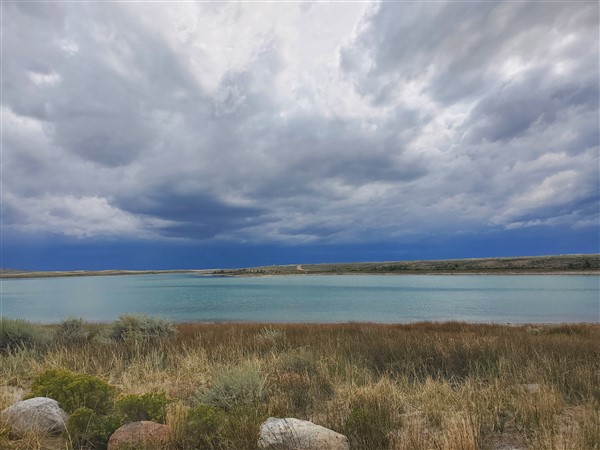
A heck of a severe thunderstorm followed by a day of RECORD solar panel performance
A few days ago the region was battered by a severe thunderstorm that looked to include the beginnings of a funnel cloud (see photo.) My camper and I experienced 70+ mph winds, unbelievably drenching rains, and some minor hail. The storm lasted for well over an hour. Four days later, there are still puddles in some places!
It appears the storm cleaned the atmosphere as my solar panels absorbed 110 amp hours the following day! On a good day, at this time of year and at this altitude, I may reach the high 90’s for amp hours.
My theory for the enhanced performance from my solar panels? Since thunderstorms reach to 50000 ft. in the atmosphere (and sometime higher), our entire region was “rinsed” of atmospheric dust and anything else airborne – at least for a day or so. I’d welcome your thoughts on this.
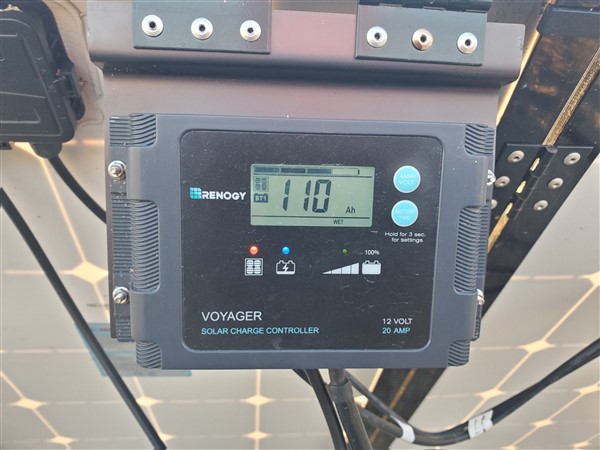
Solar Panels are VERY sensitive to clouds and more…
If you want to get the most out of your solar panels, they need to be in direct sunlight. Any cloud cover, dust, smoke, or shade will significantly reduce their ability to absorb solar energy. This is one major reason I will not purchase roof mounted solar panels for my camper. If you camp (park) your RV under a tree to enjoy the shade it produces, there goes your solar panel’s effectiveness!
A bit about my solar panels and other equipment that enable boondocking – and the equipment did NOT cost me a kings ransom!
I use the 200 watt Renogy Solar Suitcase. I really do have a lot of respect for the Renogy company and I can also attest to their superior tech support and customer service. When not in use, it easily fits in my storage bay.
The Renogy Solar Suitcase comes in two “flavors” – 100 watt and 200 watt. When you check the link to the suitcase, look for the systems with the waterproof controller (built into the case.) The controller is an electronic device that allows the panels to “talk” to your camper’s batteries. It is designed to work with any type of RV battery – deep cycle lead-acid, AGM, or lithium ion.
Interestingly, since I purchased my solar suitcase, prices have declined! The Renogy Solar Panel system comes with a 10 ft. cable to enable some distance between your solar suitcase and your camper. I purchased a 10 ft. extender cable (scroll down Amazon page to locate this extra cable) to enable more flexibility in situating the panels in the sun. Don’t overdo it with extra lengths of cable though as direct current loses about 1.5% of the energy for every 10 ft. of cable.
Inverters to improve your RV Boondocking (dry camping) Experience
As you may know, the “job” of the solar panels is to charge your RV’s batteries (if you’re in a motorhome, its the “house” batteries.) Charged batteries can run all the 12 volt systems in your camper. You may however need to run some equipment designed to operate on household (120 volt AC) current. Within reasonable limits, this can be done – with an inverter.
Inverters connect to your 12 volt D.C. (direct current) batteries and convert 12v DC to 120 volt AC (alternating current.) Inverters enable you to operate AC appliances or equipment in your camper. Depending upon the wattage rating for the inverter, it determines which AC appliances can be operated. In my situation, I’m quite happy seeing my laptop charger, phone charger, AeroGardens, and perhaps TV operate. These are all LOW wattage AC appliances.
Your batteries ultimately govern how much you can run and for how long. In my case, I have a new pair of 6v deep cycle, lead acid DuraCell 235AH (amp hour) batteries. recently I wrote a post on batteries here – in which I explain what I purchased, from where and why. If I did more dry camping (boondocking), I’d entertain buying 2 more of these batteries. So far, I’m impressed with these batteries, and they were NOT expensive (about $360. for the pair.) For the record, generally, I boondock about 1 month per year or less.
My Inverter and my future inverter…
I currently use the Bestek 1000 watt PURE SINE WAVE inverter. It is inexpensive and does fine when I connect an extension cord to it, run it into my camper and operate any/all of the appliances/equipment noted earlier. I’m not up all night (when the solar panels provide nothing), so I have yet to run out of battery power as I bathe my plants in light and work on my laptop. I have no desire to run the A/C, microwave or anything with a heating element as these are high wattage AC appliances.
I have noted during this most recent boondocking experience that the Bestek 1000 watt does NOT like to be connected directly to the main power connection of my camper. Why? There are “hidden” draws of power when you try to power up the camper. The #1 draw is likely the converter inside your camper. The draw from the campers converter along with the additional draws I’m demanding of it exceed its 1000 watt capcity.
Thanks to advances in inverter technology and reductions in the COST of said technology, Renogy now offers an affordable 2000 watt PURE SINE WAVE inverter. Pure sine wave is important as some equipment – including your laptop – need this type of AC power. Thanks to price decreases, the Renogy 2000 w is available for under $300.
While I do not yet own one, I am confident it will have no issue serving power to my entire camper (again within reasonable limits.) Again, I have ultimate confidence in the Renogy name. Again – I must emphasize that drawing significant power through your inverter will tax the RV’s batteries. You must give some thought as to how many amp-hours of battery power do you require. In my case, 235AH has proved to be the “magic number.”
Connecting an Inverter to your entire camper – the nuts and bolts…
I simply use the 15A, 120v “household” outlet on the inverter to run an extension cord to my 50A connector on the side of my camper. Of course, I needed some (2) adapters. These are detailed on the link to electric accessories in my RV Accessories section of my website. You will ultimately need a 15 to 30A connector and a 30 to 50A connector (if your RV camper is wired for 50A service.)
Let’s talk GENERATORS for your RV for a moment…
When it comes to generators, I have a few simple requirements: compact, lightweight and quiet. I chose the Champion 2500 dual fuel (runs on gasoline and propane.) It generally sells for under $500., is fully capable of charging the batteries and running low wattage AC appliances/equipment, weighs UNDER 40 pounds and CAN BE paralleled with another Champion 2500 to produce enough wattage to run the air conditioner or microwave.
Two Champions with a parallel kit will cost you UNDER $1200. and can be handled by virtually anyone. The problem I have with a 3500 or 4000 model (which is about what two of mine paralleled together can produce) is their weight – I’ve yet to see a 3500 or 4000 that weighs much under 90 pounds – and for me that’s a deal breaker!
Why a generator when you have solar panels?
Simple, some days have very limited (or no) sun. On those days, you’d better have a “backup” source of energy or you’ll risk damaging your batteries, especially if they’re lead acid or AGM.
Final Thoughts and upcoming adventures…
The entire solar set up (with a generator) adds up to just over $1000. Very affordable when you consider the cost of RV campgrounds these days. Ever since the “you know what” ‘demic in 2020, RV parks have raised their rates quite a bit. Time will tell whether this is a permanent change.
Once I leave Soda Lake, I believe I’m heading for a respite in Saratoga (gotta hit the hot springs!) and then some time in Vernal, Utah before heading to ski country. Exactly where in ski country is still in flux. I’m confident it will be in Utah, Wyoming, or Idaho. I will of course let you know once I figure it out.
A final thought: If you’re like me and you RV camp in the winter, be sure to read my post about RV skirting. Even though days are still in the 70’s here and we’ve yet to see a night below 40F, those days are coming and if you live anywhere north of Texas or Florida, you WILL benefit from an RV skirt.
If you like my content, please leave a comment below and/or sign up for my newsletter in the form below. Thanks!
Note: Several of the links in this post (and many of my posts) are affiliate links. I only recommend products I personally use or have tested. Any affiliate income from my links helps to defray website related costs.
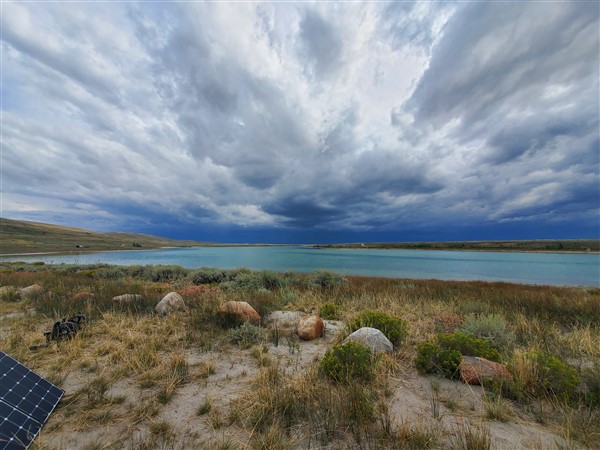
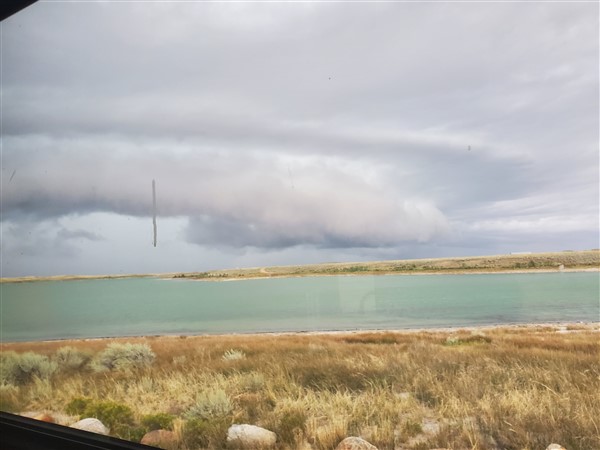

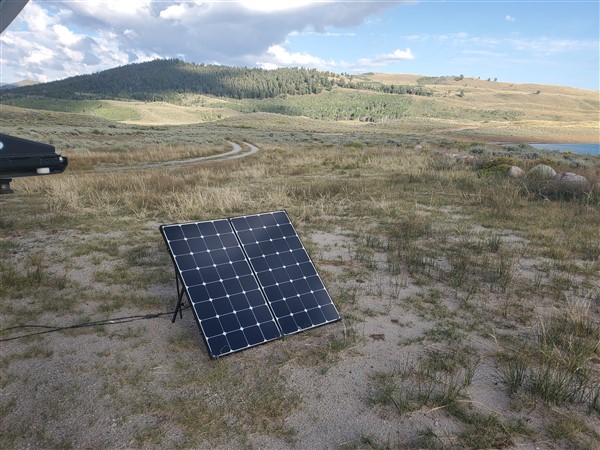

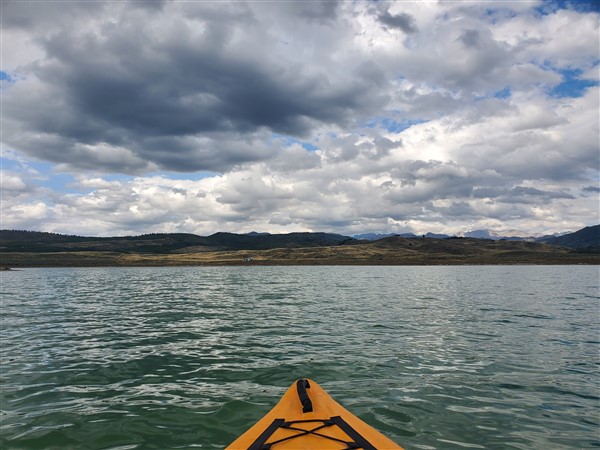
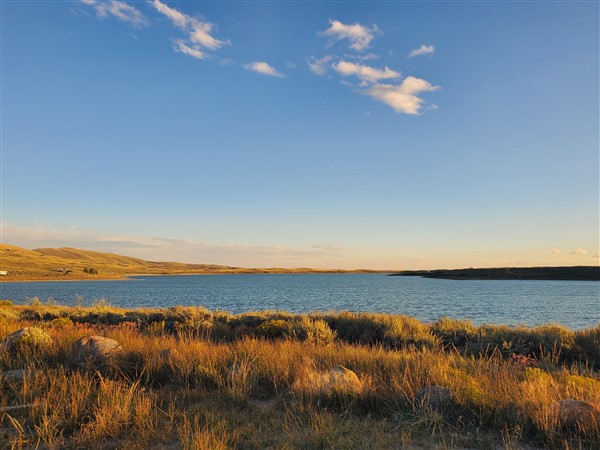
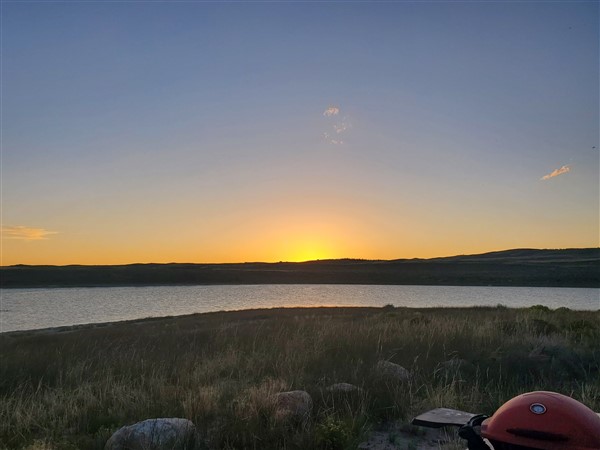
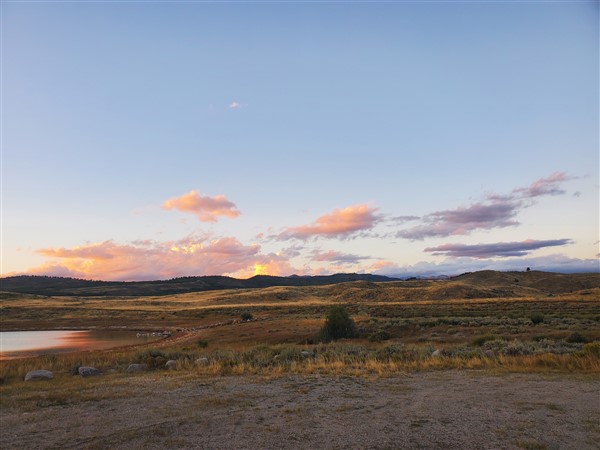
Good article on Solar without breaking the Bank. We use a similar set up with 2 6v GC batteries and a 200W Renogy suitcase, I do have 170 on the roof but as you stated the suitcase allows me to chase the sun.
I do not use an inverter and want to ask to make sure I understand how you power the inverter. Do you simply run the extension cord from inverter to your outside 30 amp in my case outlet and plug what ever appliance you are using into the inverter?
Also have Champion dual fuel inverter generator which we rarely need to use unless we need AC. We intentionally dry camp in higher altitudes in the summer so generally do not need AC. I did add soft start to my AC, one 13.5 unit of my rig and the Champion runs the AC without big power drop.
Thanks again for a practical article on cost effective solar.
Ken,
Thanks for sharing. My latest post will elaborate upon how I connect the inverter to my low wattage AC equipment. https://rvacrossamerica.net/rv-dry-camping-boondocking-101-how-to-prepare-for-a-great-off-grid-experience/ Let me know if this post clarifies things.
Al